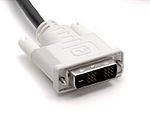Digital Visual Interface
 
A male DVI-D (single link) connector.
|
|||
| Type | Digital computer video connector | ||
|---|---|---|---|
| Designer | Digital Display Working Group | ||
| Designed | April 1999 | ||
| Produced | 1999–present | ||
| Superseded | VGA connector | ||
| Superseded by | HDMI (2002) | ||
| Hot pluggable | Yes | ||
| External | Yes | ||
| Video signal | Digital video stream: Single Link: 1920 × 1200 (WUXGA) @ 60 Hz Dual Link: 2560 × 1600 (WQXGA) @ 60 Hz Analog video stream: 1920 × 1200 (WUXGA) @ 60 Hz |
||
| Pins | 29 | ||
| Data signal | RGB data, clock, and display data channel | ||
| Bitrate | (Single link) 3.96 Gbit/s (Dual link) 7.92 Gbit/s |
||
| Max. devices | 1 | ||
| Protocol | 3 × transition minimized differential signaling data and clock | ||
 |
|||
| A female DVI-I socket from the front | |||
 |
|||
| Color coded (click to read text) | |||
| Pin 1 | TMDS data 2− | Digital red− (link 1) | |
| Pin 2 | TMDS data 2+ | Digital red+ (link 1) | |
| Pin 3 | TMDS data 2/4 shield | ||
| Pin 4 | TMDS data 4− | Digital green− (link 2) | |
| Pin 5 | TMDS data 4+ | Digital green+ (link 2) | |
| Pin 6 | DDC clock | ||
| Pin 7 | DDC data | ||
| Pin 8 | Analog vertical sync | ||
| Pin 9 | TMDS data 1− | Digital green− (link 1) | |
| Pin 10 | TMDS data 1+ | Digital green+ (link 1) | |
| Pin 11 | TMDS data 1/3 shield | ||
| Pin 12 | TMDS data 3− | Digital blue− (link 2) | |
| Pin 13 | TMDS data 3+ | Digital blue+ (link 2) | |
| Pin 14 | +5 V | Power for monitor when in standby | |
| Pin 15 | Ground | Return for pin 14 and analog sync | |
| Pin 16 | Hot plug detect | ||
| Pin 17 | TMDS data 0− | Digital blue− (link 1) and digital sync | |
| Pin 18 | TMDS data 0+ | Digital blue+ (link 1) and digital sync | |
| Pin 19 | TMDS data 0/5 shield | ||
| Pin 20 | TMDS data 5− | Digital red− (link 2) | |
| Pin 21 | TMDS data 5+ | Digital red+ (link 2) | |
| Pin 22 | TMDS clock shield | ||
| Pin 23 | TMDS clock+ | Digital clock+ (links 1 and 2) | |
| Pin 24 | TMDS clock− | Digital clock− (links 1 and 2) | |
| C1 | Analog red | ||
| C2 | Analog green | ||
| C3 | Analog blue | ||
| C4 | Analog horizontal sync | ||
| C5 | Analog ground | Return for R, G, and B signals | |
Digital Visual Interface (DVI) is a video display interface developed by the Digital Display Working Group (DDWG). The digital interface is used to connect a video source, such as a video display controller, to a display device, such as a computer monitor. It was developed with the intention of creating an industry standard for the transfer of digital video content.
The interface is designed to transmit uncompressed digital video and can be configured to support multiple modes such as DVI-A (analog only), DVI-D (digital only) or DVI-I (digital and analog). Featuring support for analog connections, the DVI specification is compatible with the VGA interface. This compatibility, along with other advantages, led to its widespread acceptance over competing digital display standards Plug and Display (P&D) and Digital Flat Panel (DFP). Although DVI is predominantly associated with computers, it is sometimes used in other consumer electronics such as television sets and DVD players.
DVI's digital video transmission format is based on panelLink, a serial format developed by Silicon Image that utilizes a high-speed serial link called transition minimized differential signaling (TMDS). Like modern analog VGA connectors, the DVI connector includes pins for the display data channel (DDC). A newer version of DDC called DDC2 allows the graphics adapter to read the monitor's extended display identification data (EDID). If a display supports both analog and digital signals in one DVI-I input, each input method can host a distinct EDID. Since the DDC can only support one EDID, there can be a problem if both the digital and analog inputs in the DVI-I port detect activity. It is up to the display to choose which EDID to send.
...
Wikipedia
